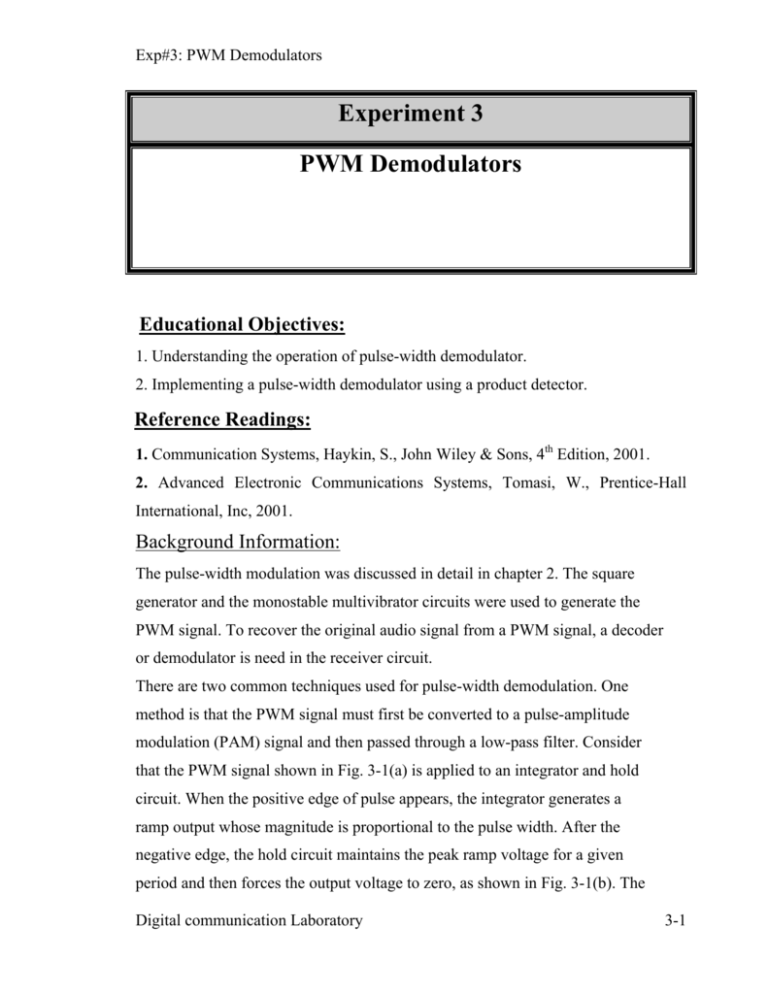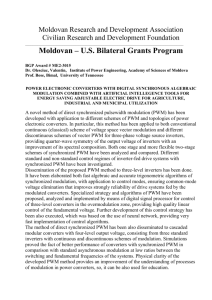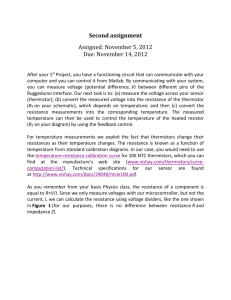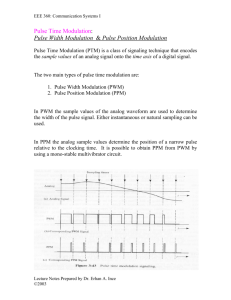Exp_10
advertisement

Exp#3: PWM Demodulators Experiment 3 PWM Demodulators Educational Objectives: 1. Understanding the operation of pulse-width demodulator. 2. Implementing a pulse-width demodulator using a product detector. Reference Readings: 1. Communication Systems, Haykin, S., John Wiley & Sons, 4th Edition, 2001. 2. Advanced Electronic Communications Systems, Tomasi, W., Prentice-Hall International, Inc, 2001. Background Information: The pulse-width modulation was discussed in detail in chapter 2. The square generator and the monostable multivibrator circuits were used to generate the PWM signal. To recover the original audio signal from a PWM signal, a decoder or demodulator is need in the receiver circuit. There are two common techniques used for pulse-width demodulation. One method is that the PWM signal must first be converted to a pulse-amplitude modulation (PAM) signal and then passed through a low-pass filter. Consider that the PWM signal shown in Fig. 3-1(a) is applied to an integrator and hold circuit. When the positive edge of pulse appears, the integrator generates a ramp output whose magnitude is proportional to the pulse width. After the negative edge, the hold circuit maintains the peak ramp voltage for a given period and then forces the output voltage to zero, as shown in Fig. 3-1(b). The Digital communication Laboratory 3-1 Exp#3: PWM Demodulators waveform Vc, shown in Fig. 3-1(c), is the sum of Vb and a sequence of constant-amplitude and constant-width pulses generated by demodulator. This signal is then applied to the input of clipping circuit, which cuts off the portion of signal below the threshold voltage Vth and outputs the reminder. Therefore the output of clipping circuit is a PAM signal whose amplitude is proportional to the width of PWM signal, as shown in Fig. 3 -1(d). Finally, the PAM signal passes through a simple low-pass filter and the original audio signal is obtained. Fig.3 -1 PWM to PAM Digital communication Laboratory 3-2 Exp#3: PWM Demodulators The other technique for demodulating a PWM signal is illustrated in Fig. 3-2. It consists of a product detector and a low-pass filter. The PWM and the carrier signals are connected to the inputs of product detector, and then a sequence of pulses having the width inversely proportional to the width of PWM pulse presents at output. When the Va signal passes through the low-pass filter, a demodulated output signal is obtained. Fig.3 -2 Illustration of PWM demodulation with product detector Digital communication Laboratory 3-3 Exp#3: PWM Demodulators Fig. 3-3 shows the internal configuration of MC1496. The differential amplifier (Q5 and Q6) is used to drive the differential amplifiers Q1Q2 and Q3Q4. The constant-current source generator (Q7 and Q8) provides the differential amplifier Q5 and Q6 with a constant current. Overall gain of MC1496 can be controlled by externally connecting a resistor between pins 2 and 3. For PWM demodulation, the PWM signal should be applied to pins 1 and 4, and the carrier to pins 8 and 10. The bias current to pin 5 is commonly provided by connecting a series resistor from this pin to the power supply. Since the detector has two outputs (pins 6 and 12), one of the outputs can be used as the detector output and the other used for the use of automatic gain control (AGC). Fig. 3-3 MC1496 internal circuit The PWM demodulator circuit using the MC1496 product detector is shown in Fig. 3-4. This circuit is similar to the AM, SSB and DSB-SC detectors introduced before. The U1 and U2 amplifiers control the input amplitudes of PWM and carrier signals within the range of 300 mVpp to 1400 mVpp, so that the detector operates in linear region. The resistor R7 connected between pins 2 and 3 determines the voltage gain of MC1496. The coupling capacitors C1, C2, C4, C5 and C9 are used to block dc signals while passing ac signals. The Digital communication Laboratory 3-4 Exp#3: PWM Demodulators VR1 and VR2 control the gains of U1 and U2, respectively. The value of VR3 determines the magnitude of PWM signal to the input of the detector. The U4 operates as a second-order low-pass filter. Fig.3 -4 PWM demodulator EQUIPMENT REQUIRED 1 - Module KL-92001 2 - Module KL-94002 3 – Oscilloscope Task to Study: Experiment 3-1 Pulse Width Demodulator 1. Locate the PWM Demodulator circuit on Module KL-94002. 2. Complete the PWM Modulator circuit in experiment 2-2. Connect a 3Vp-p, 700Hz sine wave to the audio input. 3. Connect the test point T1 of the PWM Modulator circuit to the carrier input (I/P1) of the PWM Demodulator circuit. 4. Connect the PWM modulated output of the PWM Modulator circuit to the PWM input (I/P2) of the PWM Demodulator circuit. 5. Vary the VR1 to get an output signal with minimum distortion at U1 Digital communication Laboratory 3-5 Exp#3: PWM Demodulators μA741 output. 6. Carefully adjust VR2 and VR3 until getting a proper demodulated signal. 7. Using the oscilloscope, observe the signals of PWM input signal, carrier signal, U1 output signal, U2 output signal, MC1496 output signal (pin 12), and PWM demodulated signal. Record the results in Table 3-1. 8. Remain all conditions but change the input frequency of Fig.3-7 to 500Hz. 9. Repeat steps 5 to 7 and record the results in Table 3-2. Digital communication Laboratory 3-6 Exp#3: PWM Demodulators Table 3.1 Digital communication Laboratory 3-7 Exp#3: PWM Demodulators Table 3.2: Digital communication Laboratory 3-8 Exp#3: PWM Demodulators Table 3.3 Digital communication Laboratory 3-9 Exp#3: PWM Demodulators QUESTIONS 1. In Fig. 3-4, what are the functions of the VR1 and VR2? 2. In Fig. 3-4, what is the function of the VR3? 3. As the audio frequency of Fig. 3-7 goes down, what components of Fig. 3-4 must be modified for normal operation? Digital communication Laboratory 3-10








